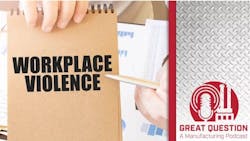Podcast: Building a workplace violence prevention policy at your plant
Matt Doherty is managing director of the workforce risk management team at Sikich and has over 30 years of experience in both the government and private sectors. He is known for his work in violence prevention and threat assessment and management.
In his current position, Doherty helps organizations build and expand violence prevention programs; assess and manage violence risks; train and empower workforces; and gain the business benefits that come with safe and supportive workplaces.
He recently spoke with senior editor Adrienne Selko of EHS Today, a sister brand to Smart Industry, about California Senate Bill 553, which will require nearly all employers in the Golden State to establish, implement, and maintain a detailed workplace violence prevention plan.
Below is an excerpt from the podcast:
EHST: So, a lot of companies do have workplace violence policies. How will this new bill affect those policies?
MD: Well, first of all, it's been our experience in the last 15 years of developing workplace violence prevention policies, programs, and training, as well as consulting on serious situations in the workplace, that many companies think they have policies on workplace violence, when in actuality, they have a plan to respond to an act of workplace violence or an active assailant.
Podcast: Say goodbye to 'robot wranglers'
So, they're conflating the two. What is a workplace violence prevention plan, which is the California mandate, versus a response plan or active assailant? That's a fundamental conflation, if you will, that a lot of companies are making. But even if they have a pretty sound policy or program or training, the policies will need to be revised, definitely, to fully encompass the directives of 553, which are extensive. Most companies have a one-sentence statement in their handbook. It's just amazing.
We've been looking at workplace violence prevention policies and developing programs, and oftentimes, even with large sophisticated corporate companies, let alone 10 or more employees, which this requires, we'll ask them for their workplace violence prevention policies, and we'll get a one-sentence epiphany in the employee handbook that workplace violence won't be tolerated.
See also: VR on the factory floor boosts safety, innovation, efficiency
And they're not considering all of the issues that are out there that, if you don't have early intervention, can potentially escalate. But 553 compliance involves a written plan, active employee involvement, hazard identification and correction. You know, if there's somebody in a retail establishment, they bring up the example, and they are in charge of emptying the trash out in the back alley, there must be proper lighting. Those types of physicalities. And there's record keeping. And there's specific training requirements and emergency response procedures and ongoing updates.
Podcast: Operations Leadership Summit updates
So, it's a proactive report approach, and it's a living, breathing document that you have to constantly update and keep up to date, including who's assigned. So, it's even if a company thinks they have a robust and good plan, which they very well could, it still would not meet, in all likelihood, the compliancy of 553.
EHST: OK. And that brings up the point that, you know, whether or not workplaces really understand the breadth of workplace violence that extends beyond an active shooter situation. There's harassment and intimidation, and there's other things that happened prior to the violence, but it's all part of how we would define workplace violence.
MD: That's right. There are some myths out there. I'm fairly confident that if you are an employer and a fight breaks out or an overt threat of physical violence or overt sexual harassment occurs, that gets reported. There's also a myth out there that we're just talking about co-worker versus coworker violence. Well, that's not the case.
Podcast: What’s the latest in workplace safety?
There are four types of people that have to be categorized by this California OSHA law.
- Type one, for instance, is criminal intent, which is where the person has no legitimate business there and commits crimes at the workplace.
- Type two could be a customer, client, visitor, or vendor, where it's directed at the employees by those individuals.
- Type three is worker on worker, which is violence against an employee by a president or former employee or supervisor or manager.
- Last but not least is Type four, personal relationships. When you hear that 40% of women killed in the workplace are killed by an intimate partner, that's one example. But somebody that has or is known to have had a personal relationship with the employee. So now the categories of people have been mandated and expanded.
About the Podcast
Great Question: A Manufacturing Podcast offers news and information for the people who make, store, and move things and those who manage and maintain the facilities where that work gets done. Manufacturers from chemical producers to automakers to machine shops can listen for critical insights into the technologies, economic conditions, and best practices that can influence how to best run facilities to reach operational excellence.
About the Author
Scott Achelpohl
Head of Content
I've come to Smart Industry after stints in business-to-business journalism covering U.S. trucking and transportation for FleetOwner, a sister website and magazine of SI’s at Endeavor Business Media, and branches of the U.S. military for Navy League of the United States. I'm a graduate of the University of Kansas and the William Allen White School of Journalism with many years of media experience inside and outside B2B journalism. I'm a wordsmith by nature, and I edit Smart Industry and report and write all kinds of news and interactive media on the digital transformation of manufacturing.

